-
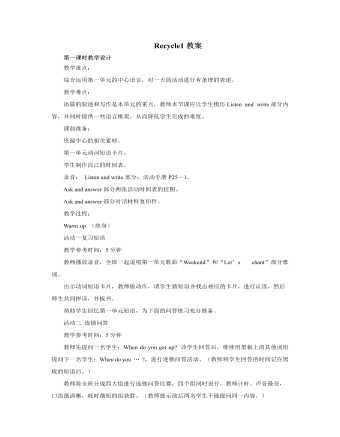
人教版新课标PEP小学英语五年级下册Recycle1教案(内容详细)
学生搜集中外重要节日及部分中外名人的生日所在的月份。教师准备相关节日及部分中外名人的图片或音像资料片。教师课前准备Let’s find out2的配图画好春、夏、秋、冬四个方框。录音:Listen and number。教学过程:Warm up (热身)活动一复习单词教学参考时间:3分钟(1)教师播放Let’s chant部分的歌谣,学生听一遍后跟唱。(2)出示带有各个月份特征的单词卡片。学生看图说出单词,并一起拼读其缩写形式。帮助学生在有节奏的说唱中巩固记忆单词,为在后面活动中学生能够熟练应用作铺垫。活动二 复习句子教学参考时间:5分钟(1)师生同唱Let’s chant部分歌谣“When Is Your Birthday?”。(2)教师引导学生看歌谣下面的翻滚过山车的动画,师生进行问答,如:When is the rabbit’s birthday? It’s in May. 等。教师示范后请学生进行Pair work,也可以展开竞赛的形式进行“连锁问答”。巩固有关生日问答的语句,为Let’s find out1的活动做准备。
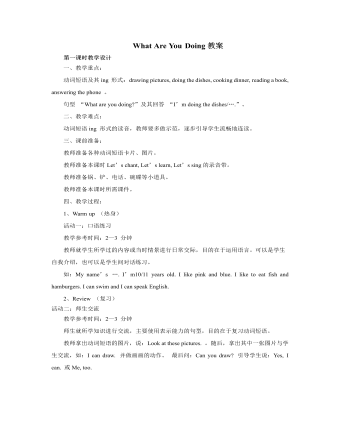
人教版新课标PEP小学英语五年级下册What Are You Doing教案
教学参考时间:2—3分钟教师让学生说出几个家庭成员名称,如:father, mother, sister, brother, uncle等,自己或让学生把单词写在黑板的一侧,再让学生说出几个动词短语的-ing形式,如:washing clothes, writing an e-mail, watching TV等,写到黑板的另一侧。学生在家庭成员名称和动词短语中分别选三至四个,自己编成一首歌谣。课后,可以让学生将创作的歌谣进行展示或举行歌谣朗读比赛。5、Consolidation and extension (扩展活动)活动十:知识扩展教学参考时间:1—2 分钟教师让学生打开书第54页Good to know 部分,了解主要国家的紧急救助电话。如:美国,英国,加拿大,澳大利亚等。教师还帮助学生了解我国的紧急救助电话号码。教师可以利用道具电话让学生做游戏。活动十一:练一练教学参考时间:2—3 分钟做本单元B Let’s talk部分的活动手册第37页的配套练习。教师讲解题目要求。教师播放录音,做Listen and number 部分练习。要求按所听内容在图上写出序号。再次播放,让学生按录音内容填空。鼓励学生自己读读所写句子。
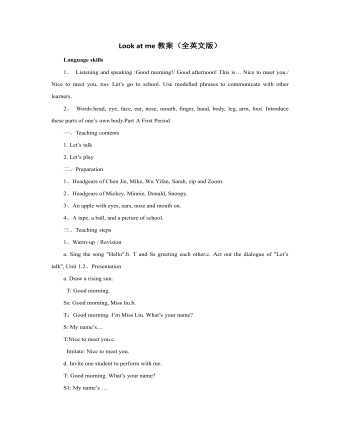
人教版新课标PEP小学英语三年级上册Look at me教案(全英文版)
3、Practicea. Nice to meet you. Nice to meet you,too.b. Perform the dialogue.c. Arrange the dialogue according to the pictures or sentence cards.d. Let’s play.A: Good afternoon,B. This is C. Hello, C! Nice to meet you.C: Nice to meet you, too.A,B: Goodbye!C: Bye!4、Assessment Workbook page 10Add-activitiesa. Listen to the recording and repeat.b. Make a dialogue according to "Let’s talk".Second Period一、Teaching contents1. Let’s learn Words:body, leg, arm, hand, finger, foot.1. Let’s do二、Preparation1、a puppet2、Cards of body, leg, arm, hand, finger and foot.3、headgear of a captain三、Teaching steps1、Warm-up/ Revisiona. Captain says to review "let’s do" of Part A.b. Perform the students their own dialogues.2、Presentationa. Learn to say "body, leg, arm, hand, finger and foot."b. Listen to the recording and repeat.c. Let’s do. Clap your hands. Snap your fingers. Wave your arms. Cross your legs. Shake your body. Stamp your foot.3、Practicea. Let’s draw a person.b. Let’s do. Point out which picture.c. Let’s do. Who responses faster.4、Assessment Workbook page 115、Add-activitiesa. Listen to the recording, repeat and act out.b. Say all the names of the body to your parents.Third Period一、Teaching contents1. Let’s check2. Let’s chant二、Preparation1、stationeries1、pictures of parts of Zoom

部编人教版三年级上册《古诗三首 赠刘景文》说课稿
一、说教材《赠刘景文》这首古诗的作者是苏轼。这首古诗是写秋末的景色,第一句以荷败、菊残,写出了秋末的特征。接下来诗人以橙子的金黄与橘子的青绿,把深秋的景色点缀得色彩鲜明而富有生气。诗人在此一反悲秋的调子,突出了秋天是收获的季节。第二行诗赞颂了菊花的残枝有傲霜凌寒的气概。二、说教学目标1.学会本课生字,重点理解诗句中“擎、残、犹”的意思。了解诗句的含义。2.能正确、流利、有感情地朗读古诗和背诵古诗。3.通过对诗句的诵读感悟,培养学生丰富的想象力和语言表达能力。体会诗中描绘的浓浓秋色,感受诗歌美的意境和深刻的哲理。4.通过学习课文,唤起学生面对生活要乐观向上,不泄气,珍惜现在的大好时光。三、教学重、难点1.通过“欣赏意境”的训练和利用画面再现,从词义理解到理解全句、全篇,来帮助学生领悟、感受全文。(重点)2.通过对诗句的诵读感悟,培养学生丰富的想象力和语言表达能力。体会诗中描绘的浓浓秋色,感受诗歌美的意境和深刻的哲理。(难点)

人教版新目标初中英语八年级下册What should I do教案2篇
说明:在帮Li Lei提建议的同时,教育学生如何学好英语。第三课时教学目标1. 语言目标:a) 词汇: Original, in style, haircut, the same as.b) 语言结构:My friend wears the same clothes and has the same haircut as I do.2. 能力目标:大多数学生能够谈论自己喜欢哪种服装,提高查找信息的能力。3. 情感目标:学会如何与朋友相处,要有自己对时尚的看法。教学重点掌握一些重要词汇。教学难点学会谈论问题,并能提出书面建议。◆教学突破首先针对Erin的问题,提出个人的建议,模仿2c部分的对话展开双人交际Pair-work;听老师诵读3a部分的信件,并找出LEFT OUT的问题所在;学生完成3b部分的内容,给Left Out提出书面的建议;学以口头形式提出自己目前存在的某个问题,讲给大家听,让同学们给自己提出一个建议,并作笔录;学生两、三个人分成一组,随意性地进行口语交际,谈论P14的第4部分的某个问题,相互交换意见。

人教版新目标初中英语八年级下册It’s a nice day, isn’t it教案2篇
"Hello! Welcome to English class! Introduce yourself. Meet your new classmates." That's what the teacher says. What do you say? "Oh no!" It can be difficult talking to new people. But it can be fun, and you can make friends. How do you do it? Make small talk. Small talk is polite conversation. "Wang Nan is a great pingpang player, isn't she?" "I'd love to meet her, wouldn't you?" "It's been raining a lot, hasn't it?" Tag questions are a form of polite speech. To make small talk successfully, you should know how to make them. You should also know what topics to talk about. Try to learn this unit carefully. The next time you're in English class, you'll find out. Making small talk's easy, isn't it? (“你好!欢迎你!请做一下自我介绍。认识一下你的新同学。”通常在课上老师会这样说。你会说什么呢?“噢,不!”与陌生人谈话太困难了。但是这也很有意思,并且你还能交到朋友。你该怎么做呢?闲聊。闲聊指得是礼貌的对话。“王楠是一个很棒的乒乓球运动员,不是吗?”“我希望自己能认识她,你呢?“今年的雨水很多,不是吗?”反意疑问句是一种礼貌用语。为了使得谈话成功,你应该知道怎样去进行闲聊。你还应该知道与不同的人该谈论什么样的话题。认真的学习这个单元吧,下次在英语课上,你会发现与大家展开谈话是一件很容易的事情,不信我们来试试。)

人教版新目标初中英语八年级下册Have you ever been to an amusement park教案
(1)Have you ever been to …? Yes, I have. / Yes, I have ever been to …No, I haven’t. / No, I have never been to …(2)When did you go there? I went there last year. (3)I have never been to a water park. Neither have I. I have ever been to an amusement park. So have I. (4)How long have you been studying English? I’ve been studying English since nine o’clock. I’ve been studying English since I came back home. I’ve been studying English for five hours. (5)What’s that? It’s an amusement park in Japan. I’ve never been to an amusement park like it before. It’s fun to learn another language. Let’s go tonight. Isn’t this great?space museum, amusement park, water park, South America, Peru, Holland, European culture, tour guide, flight attendant, musical instrument, more than, be from, get to, take lessons, neither, discover, graduate, change

人教版新目标初中英语八年级下册If you go to the party, you’ll have a great time教案2篇
区分宾语从句、定于从句和状语从句宾语从句和状语从句,都叫做主从复合句。宾语从句主要是中考必考的,是初中阶段必掌握的从句,宾语从句主要是掌握三要素,所谓宾语从句,就是宾语在主从复合句当中充当宾语的一个句子,叫做宾语从句。主句的谓语动词是及物动词,后面如果是词或者是短语的话,是简单句,如果是句子的话,肯定是宾语从句。I know that he good at English.就是宾语从句,三要素,一要素是要注意连词,连词一共学了三类连词,一类连词是that口语当中可以省略,就像刚才说的那一句,I hear he is good at English.还有疑问代词、疑问副词,how where when,疑问代词、疑问副词。还有一类连词weather是否的意思,不是状语从句当中的如果,这一定要和如果区分开,这是是否。I don't know if he interested at English。宾语从句要注意if是连词。第二要素是语序,要用陈述举语序。比如说你家有几口人,我们都说How many people are there in you family?但是这是简单句,一旦说成宾语从句,你可以告诉我你家有几口人吗?Could you tell me how many people there are in you family ?

人教版新目标初中英语八年级下册He said I was hard-working教案2篇
This activity introduces some new vocabulary and provide oral practice using the target language.Task 1 . Ask four students to stand in front of the class, and the teacher asks them the following questions as a reporter.1.What are you going to do when you grow up?2.What are you going to do next week?3.What are going to do after school?The students will give different answers, then ask a good student to report what they said.I am going to e a doctor.What did she say?----------She said she was going to be a doctor.I am going to have a party on Friday night.What did he say?-------He said he was going to have a party on Friday night.I am going to do my homework.What did she say ?------ She said she was going to do her homework.I am going home after school.What did she say?-----She said she was going home after school.Say In this unit we are going to learn to use words like to report what someone said.Task 2. Read the instructions. Then ask a student to read the four questions. And write the words on the Bb. Explain what soap opera is.Task 3. Ask the students to Look at the pictures, point out the TV screens in the picture. Ask one girl to read what Marcia said.What did Marcia say? She said She said she was having a surprise party for Lana on Friday night. Repeat the other pictures in the same way.Activity3. Listen and number the pictures in activity 1a.

人教版新目标初中英语八年级下册How long have you been collecting shells教案2篇
Step Ⅱ Show the new words on the screen and teach the new words. Read the new words to students and ask them to repeat.Step Ⅲ 3aThis activity introduces new vocabulary and provides reading practice using the target language.In this activity first look at the four pictures.T: What can you see in the pictures?Ss: Four snow globes.T: Right. There are four snow globes in the pictures. And what are they?Ss: They are a monster, two polar bears, two penguins and a birthday cake.Write these words on the blackboard: snow globe; monster; polar bear; penguin and birthday cake. Read them to the class and ask students to repeat each one. Make sure students understand each word.Use a computer to show the E-mail message on the screen and read the message to students.Get students to read the e-mail on their own, and then draw lines connecting each snow globe and its description.Correct the answers.AnswersA line should connect each snow globe picture with the words that describe it in the letter.Step Ⅳ 3bThis activity provides writing practice using the target language.First review Activity 2a on Page 47.Then ask students to complete the message according to Activity 2a.Some partial sentences are given to students. Write about one person's collection.When students work, walk around the room checking the progress and offering help as needed.When they finish, ask some students to read their messages to the class.

人教版新目标初中英语八年级下册What were you doing when the UFO arrived教案2篇
(一).知识方面: 1.培养学生能运用过去进行时来描述、谈论过去某个时间正在发生的事情或动作的意识和能力,能就过去某个时间正在发生的动作做出正确的描述。 2.培养学生的想象力和角色扮演的合作能力。 3.培养学生讲述过去发生的事情经过的能力。能正确运用一般过去时来讲述故事。 (二).技能方面: 1.本单元的语言目标是Talk about past events and tell a story(谈论过去的时间和讲述一个故事),围绕这一目标,要涉及句型: What were you doing when the UFO arrived? ----I was sitting in the barber’s chair. The barber was cutting my hair. 因此必须学习standing、studying、cleaning、sleeping、cooking、making、eating、cutting、等表示地点的词,以便为上述句型提供语言材料。2.学习过去进行时的有关知识。Was/were+现在分词,是该时态的表达式。 3.在学习过程中,要区分The boy was walking down the street when the UFO landed.和While the boy was walking down the street, the UFO landed.这两种由when和while引导的状语从句的句型结构。注意它们的不同。

人教版新目标初中英语八年级下册Why don’t you get her a scarf教案
教师带领学生复习有关描述宠物的词汇,采用教师提问学生回答的方进行。如:T:What animals do you think would be good pets?What animals do you think would be bad pets?What do you think are good animals for a six-year-old child?然后学生进行 pairwork 练习。Task two: 师生互动,学习探究 1、播放3a部分的录音,引导学生一边听录音,一边跟读。2、通过听录音学生回答以下问题:Why do you think pot-bellied pigs are popular?What are the advantages and disadvantages of keeping such a pet?教师对学生的回答进行及时点评。3.学习范文,学习重点短语,为下步的模仿写作提供语言素材。T :1. )Have you ever kept a pig as a pet?Do you like pigs? St.:No.…Why don’t you like to keep a pig? St: No.They’re too dirty and lazy(Do you know in some foreign countries like Hollyland, Australia,pigs are the most popular pet.there’s a kind of pig.(图)it has an interesting name? it ‘s called a pot-bellied pig.) Now,let’s learn an article about this kind of interesting pet.2.)play the tapeSt.:Listen and repeat3.)show some Qs on computer(本子St.: read silently,then answerthe Qs(本子)4.)Ask ss. Close book and retell this passage.(what is a pot-bellied pig? Is it a good or bad pet? ) St.: retell it to each other“A pot –bellied pig is a popular pet now…”5.read the article together.St.:.practice reading

人教版新目标初中英语八年级下册Would you mind turning down the music教案
Step 4. Group work (4)1. Ask a pair of students to read the dialogue. Say, This activity provides speaking, listening and writing practice using the target language.2. Ask students to complete the work in groups.3. Check the answers with the whole class. 4. Explain some of the language points. Step 5. Word review (Self check 1)1. Ask students to read the words and the phrases given. 2. Fill in the blanks with proper forms of these words to complete the sentences. 3. Check the answers with the whole class. Homework:Do activity 2 on page 57 after class. Period 6Teaching aims: 1. Teach vocabulary words and the useful expressions. 2. Enable the students to learn etiquette in different culture. 3. Help the students learn how to behave politely in public places and in daily life. Teaching procedures:Step 1. RevisionHelp students to review the function of making requests through a free talk. Then lead them to the topic of etiquette. Explain the meaning of etiquette. Or, ask students to look it up in the dictionary. Step 2. Pre-reading (Section 1)1. Ask students to read the picture and make a list with their partner about how many rules of etiquette can be seen being broken.
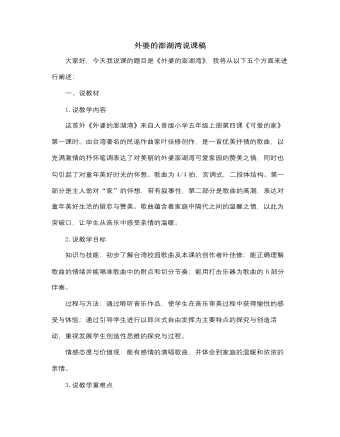
人音版小学音乐五年级上册外婆的澎湖湾说课稿
㈢拓展(十分钟)利用打击乐器为歌曲B部分伴奏:这一部分在学生能完整并且熟练演唱全曲后,为了丰富这首曲的音乐色彩,我会引导学生小组合作利用简单的打击乐器为歌曲的B部分配上伴奏,并请学生分成三个组,分别为三角铁组、沙锤组、伴唱组。这里我会看学生的反应,如果学生有较强的节奏感,那我就会让他们自己自由的为歌曲编配伴奏,如果这方面弱一点,我就会给他们指定伴奏节奏,通过练习再为歌曲伴奏,伴唱组设计自己的声势节奏,等三角铁组和沙锤组熟练掌握伴奏节奏后,请演唱组边演唱B部分边拍声势节奏,并加入三角铁和沙锤组的伴奏。最后,完整演唱全曲,A部分请全体学生随音乐边唱边律动,B部分加入打击乐器伴奏,我会弹着钢琴加入完成这一次的师生合作演出。
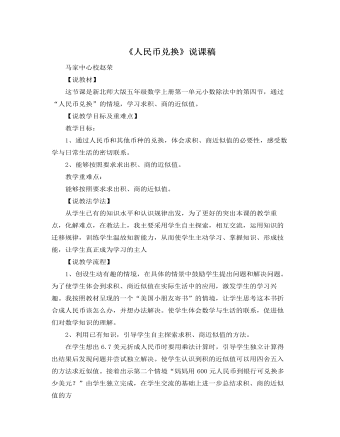
北师大版小学数学五年级上册《人民币兑换》说课稿
2、利用已有知识,引导学生自主探索求积、商近似值的方法。在学生想出6.7美元折成人民币时要用乘法计算时,引导学生独立计算得出结果后发现问题并尝试独立解决。使学生认识到积的近似值可以用四舍五入的方法求近似值。接着出示第二个情境“妈妈用600元人民币到银行可兑换多少美元?”由学生独立完成,在学生交流的基础上进一步总结求积、商的近似值的方法:积取近似值是先精确计算,在根据题目的要求取近似值;商取近似值是直接根据要求多除一位,然后取近似值。3、巩固练习在学生初步掌握求积、商的近似值的方法后,我安排了教材67页的试一试,让学生体会如何按要求取近似值;教材68页的练一练,涉及到了多个国家的货币与人民币的兑换使学生进一步感受到数学与日常生活的密切联系
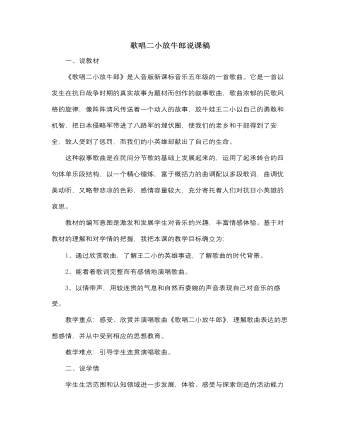
人音版小学音乐五年级上册歌唱二小放牛郎说课稿
一、说教材《歌唱二小放牛郎》是人音版新课标音乐五年级的一首歌曲。它是一首以发生在抗日战争时期的真实故事为题材而创作的叙事歌曲,歌曲浓郁的民歌风格的旋律,像阵阵清风传送着一个动人的故事,放牛娃王二小以自己的勇敢和机智,把日本侵略军带进了八路军的埋伏圈,使我们的老乡和干部得到了安全,敌人受到了惩罚,而我们的小英雄却献出了自己的生命。这种叙事歌曲是在民间分节歌的基础上发展起来的,运用了起承转合的四句体单乐段结构,以一个精心锤炼,富于概括力的曲调配以多段歌词,曲调优美动听,又略带悲凉的色彩,感情容量较大,充分寄托着人们对抗日小英雄的哀思。教材的编写意图是激发和发展学生对音乐的兴趣,丰富情感体验。基于对教材的理解和对学情的把握,我把本课的教学目标确立为:1、通过欣赏歌曲,了解王二小的英雄事迹,了解歌曲的时代背景。
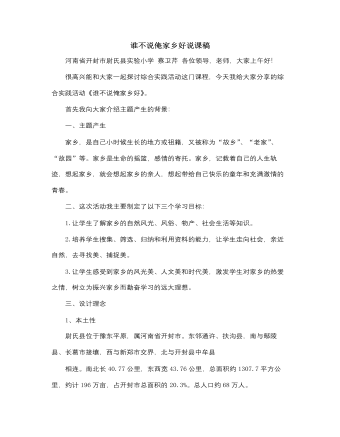
人音版小学音乐五年级上册谁不说俺家乡好说课稿
尉氏鸭蛋及养鸭基地贾鲁河畔尉氏烩面是河南烩面的一个重要分支,与其它地方不同的是尉氏烩面是羊肉浓汤锅中下面并取汤,尉氏烩面是以独家祖传秘方调制的香料配上滚滚的羊汤而成。放入羊肉丁、葱花、香菜或是五香菜,芝麻酱,同时以个人口味放入用牛羊油泼的油辣椒,浓香味美、回味无穷······人们说到尉氏县洧川镇,首先想到的一定会是洧川豆腐。有许多人也是因为洧川豆腐,才认识了洧川镇。因为这小小的豆腐在洧川镇的周边县市实在太有名了,迄今已有2000多年的历史。 洧川豆腐与众不同之处在于其表面呈琥珀色,切刀处为纯白色,韧性十足,能用麻绳串起来,可用秤钩挂着称,放在锅里越煮越筋,烹炸煎炒则风味各异。由于洧川豆腐的制作一直采用传统工艺,2011年,洧川豆腐被评为河南省非物质文化遗产。
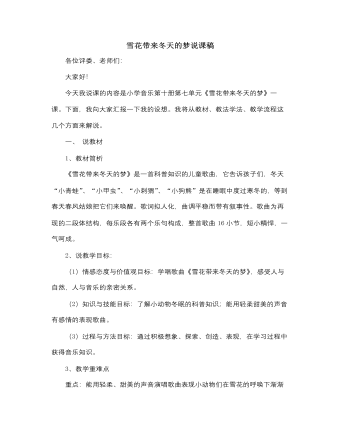
人音版小学音乐五年级上册雪花带来冬天的梦说课稿
(三)实践操作,表现歌曲。课标中指出,“表现是实践性很强的音乐学习领域,是学习音乐的基础性内容,是培养学生音乐表现能力和审美能力的重要途径。”再加上对于这个年龄段的学生来讲,他们特别喜欢表现自己,所以,我充分发挥集体的力量,设计“小小音乐家”的教学环节,让同学们在小组中合作学习,采用不同形式演唱、用打击乐器伴奏、歌舞表演等形式将唱、奏结合,唱、演结合,巩固学生对歌曲的学习,体验合作学习的快乐,养成学生共同参与的群体意识和相互尊重的合作精神和实践能力,这也更体现了课标中音乐课程价值所提出的要培养学生的“社会交往价值”。(四)拓展延伸,创编歌曲。课标中的“文化传承价值”中明确提出:“要让孩子们通过学习世界上其他国家和民族的的音乐文化,拓宽他们的审美视野,认识世界各民族音乐文化的丰富性和多样性,增进对不同文化的理解、尊重和热爱。”
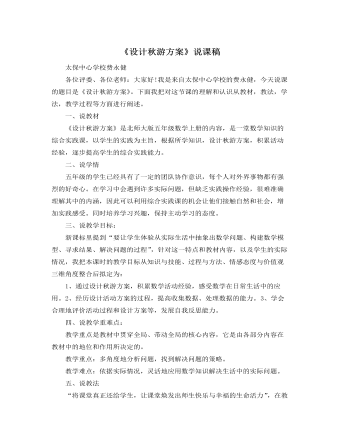
北师大版小学数学五年级上册《设计秋游方案》说课稿
六、说学法本节课的学法主要是自主探究法、合作交流法。教法和学法是和谐统一的,相互联系,密不可分。教学中要注意发挥学生的主体地位,充分调动学生的各种感官参与学习,诱发其内在的潜力,独立主动的探索,使他们不仅学会,而且会学。学生通过小组合作的方式,自主探究设计出秋游方案,然后每个小组间进行交流,最后推选出最合理可行的方案。学生通过解决生活中的实际问题,从中发现与数学之间的联系。并通过同伴间的交流、讨论等多种方法制定出解决方案,他们从生活中抽象,在实践中体验,最后在讨论中明理,从而得出了最佳的方案。七、说教学过程为了能很好地化解重点、突破难点达到预期的教学目标,我设计了三个教学环节,下面,我就从这三个环节一一进行阐述。(一)创设情境、激发兴趣
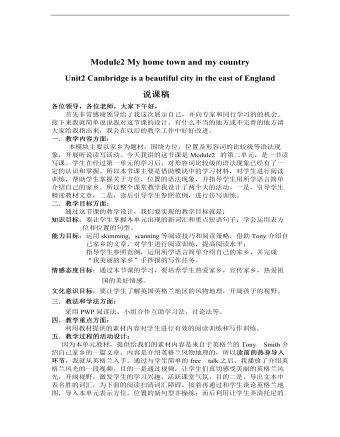
初中英语外研版八年级上册《Module 2 My home town and my countryUnit 2》说课稿
一.教学内容方面:本模块主要以家乡为题材,围绕方位,位置及形容词的比较级等语法现象,开展听说读写活动。今天我讲的这节课是Module2 的第二单元,是一节读写课。学生在经过第一单元的学习后,对形容词比较级的语法现象已经有了一定的认识和掌握。所以本节课主要是借助模块中的学习材料,对学生进行阅读训练,帮助学生掌握关于方位,位置的语法现象,并指导学生用所学语言简单介绍自己的家乡。所以整个课堂教学我设计了两个大的活动。一是,引导学生精读教材文章,二是,读后引导学生参照范例,进行仿写训练。